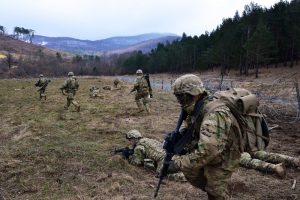The tactician must understand and master the art and the science of tactics, two distinctly different yet inseparable concepts. Commanders and leaders at all echelons and supporting commissioned, warrant, and noncommissioned staff officers must be tacticians to lead their soldiers in the conduct of full spectrum operations.
Tactics is the employment and ordered arrangement of forces in relation to each other. Through tactics, commanders use combat power to accomplish missions. The tactical-level commander uses combat power in battles, engagements, and small-unit actions. The tactical level of war is the level of war at which battles and engagements are planned and executed to achieve military objectives assigned to tactical units or task forces (JP 3-0). Activities at this level focus on the ordered arrangement and maneuver of combat elements in relation to each other and to the enemy to achieve combat objectives. It is important to understand tactics within the context of the levels of war. Read more about Tactics…

U.S. Army paratroopers assigned to 2nd Battalion, 503rd Infantry Regiment, 173rd Airborne Brigade, move toward an objective during a live-fire exercise.
Tactical operations always require judgment and adaptation to the unique circumstances of a specific situation. Techniques and procedures are established patterns that can be applied repeatedly with little or no judgment in a variety of circumstances. Tactics, techniques, and procedures (TTP) provide commanders and staffs with a set of tools to use in developing the solution to a tactical problem.
A. The Science
The science of tactics encompasses the understanding of those military aspects of tactics—capabilities, techniques, and procedures—that can be measured and codified. The science of tactics includes the physical capabilities of friendly and enemy organizations and systems, such as determining how long it takes a division to move a certain distance. It also includes techniques and procedures used to accomplish specific tasks, such as the tactical terms and control graphics that comprise the language of tactics. While not easy, the science of tactics is fairly straightforward. Much of what is contained in this manual is the science of tactics—techniques and procedures for employing the various elements of the combined arms team to achieve greater effects.
Mastery of the science of tactics is necessary for the tactician to understand the physical and procedural constraints under which he must work. These constraints include the effects of terrain, time, space, and weather on friendly and enemy forces. However—because combat is an intensely human activity—the solution to tactical problems cannot be reduced to a formula. This realization necessitates the study of the art of tactics.
B. The Art
The art of tactics consists of three interrelated aspects: the creative and flexible array of means to accomplish assigned missions, decision making under conditions of uncertainty when faced with an intelligent enemy, and understanding the human dimension—the effects of combat on soldiers. An art, as opposed to a science, requires exercising intuitive faculties that cannot be learned solely by study. The tactician must temper his study and evolve his skill through a variety of relevant, practical experiences. The more experience the tactician gains from practice under a variety of circumstances, the greater his mastery of the art of tactics.
Military professionals invoke the art of tactics to solve tactical problems within his commander’s intent by choosing from interrelated options, including—
• Types and forms of operations, forms of maneuver, and tactical mission tasks
• Task organization of available forces, to include allocating scarce resources
• Arrangement and choice of control measures
• Tempo of the operation
• Risks the commander is willing to take
Close Combat
Close combat is indispensable and unique to land operations. Only on land do combatants routinely and in large numbers come face-to-face with one another. When other means fail to drive enemy forces from their positions, Army forces close with and destroy or capture them. The outcome of battles and engagements depends on Army forces’ ability to prevail in close combat. Read more about Close Combat…
 This article is an extract from "SUTS3: The Small Unit Tactics SMARTbook, 3rd Ed. (Planning & Conducting Tactical Operations)" by The Lightning Press. Download a free PDF sample and learn more at: SUTS3: The Small Unit Tactics SMARTbook, 3rd Ed. (Planning & Conducting Tactical Operations).
This article is an extract from "SUTS3: The Small Unit Tactics SMARTbook, 3rd Ed. (Planning & Conducting Tactical Operations)" by The Lightning Press. Download a free PDF sample and learn more at: SUTS3: The Small Unit Tactics SMARTbook, 3rd Ed. (Planning & Conducting Tactical Operations).
Browse additional military doctrine articles in our SMARTnews Blog & Resource Center.
About The Lightning Press SMARTbooks. Recognized as a “whole of government” doctrinal reference standard by military, national security and government professionals around the world, SMARTbooks comprise a comprehensive professional library. SMARTbooks can be used as quick reference guides during operations, as study guides at education and professional development courses, and as lesson plans and checklists in support of training. Browse our collection of Military Reference SMARTbooks to learn more.













































